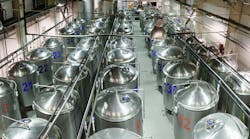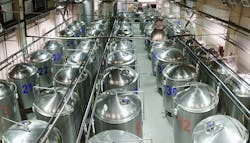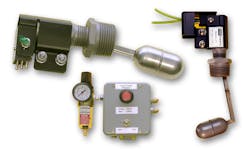Typical scenario: An alcohol distillation and fermentation plant in Texas operates between 60-100 fermentation tanks, each requiring level sensing technology to ensure the process of fermentation is properly carried out. Level sensing in alcoholic beverage production poses a set of unique challenges. In selecting a viable level sensing solution, a number of factors must be considered:
- Alcohol is a flammable liquid – safety is of paramount concern
- High pressures can be involved in fermentation and distillation operations
- Beverage industry guidelines for ensuring contaminants are not introduced by the equipment used must be adhered to
- Cost of operation must be minimized to help ensure profitability of the enterprise.
A Pneumatic Level Sensing Solution
O’Keefe Controls Co. Pneumatic Float Valves are the perfect solution for an alcohol plant’s level sensing and control needs. Their design consists of a buoyancy-style level sensor, magnetically coupled with a pneumatic output valve. The buoyant float detects the liquid level and controls the opening and closing of the pneumatic output valve accordingly. These pneumatic devices use air pressure to perform their functions; with no electrical components they are safe for use around combustible mediums, such as in our alcohol production plant. They are also employed successfully in other industries where flammable material is an issue, such as in paint and solvent production.
A Durable, Rugged and Versatile Level Sensor
With all wetted parts being constructed of stainless steel, O’Keefe Controls Co. Pneumatic Float Valves are suitable for commercial use in a variety of industries, including Food & Beverage. In fact, this construction makes them compatible with a broad range of liquids including water, wastewater, oils, alcohol, paints and solvents, and more. They are especially suited for level sensing and control in applications located in hazardous atmospheres.
Available in side-mounting or top mounting configurations, they also work for both vented and non-vented conditions. They can be utilized in level sensing applications with liquid temperatures up to 180° F and liquid pressures up to 200 psig, while their non-electric output valve can handle pressures from 30-85 psig and ambient temperatures up to 120° F. These features make them versatile enough to be used in many applications across multiple industries.
Unique Design Allows Lower Cost of Operation
In the O’Keefe Controls Co. Pneumatic Float Valve, the level sensor and pneumatic output valve are separated by the solid wall of the unit's pressure vessel. This packless design provides a float on one end of an arm and a magnet on the other. This arm is on the wet side of the sensor housing and is exposed to the liquid being sensed. As the float rises with the rising liquid level the magnet drops on the other end of the pivoted arm. As the float falls with a falling liquid level, it pivots the magnet upward. A magnetically actuated sensor on the outside of the solid metal housing reacts to the inner magnet movement. The movement shifts a 3-way air valve. The valve enters an actuated state only when the sensor is triggered thus conserving energy costs on compressed air flowing through the sensor.
Due to their pneumatic operation and innovative design, our alcohol production plant was able to solve their level-sensing needs with O’Keefe Controls Co. Pneumatic Float Valves, while keeping the cost-of-ownership low. As offered standardly or with the opportunity for project-specific customization, O’Keefe Controls Co. Pneumatic Float Valves are utilized for level sensing and control across a diverse array of industries.
To learn more about O’Keefe Controls Co. Pneumatic Float Valves or to find the level sensors and controls best suited for your application Click Here.






